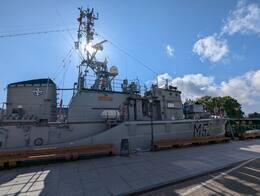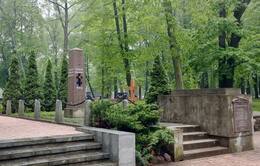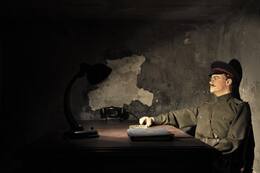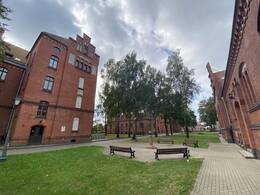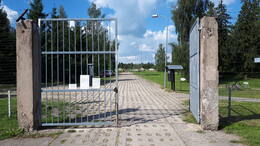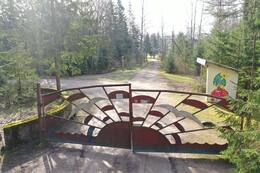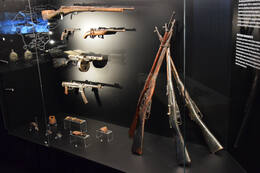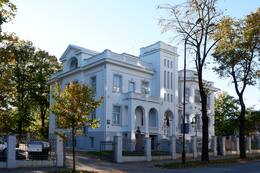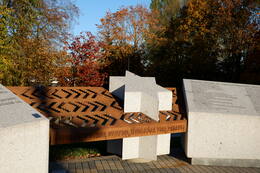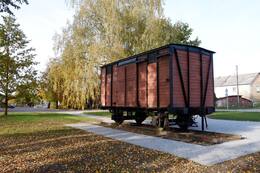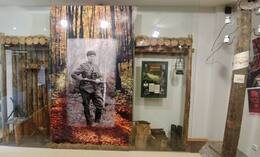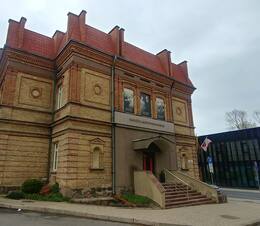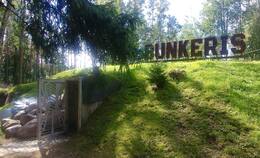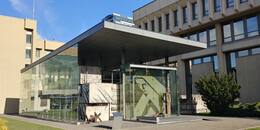Sovietinės Lietuvos paveikslas
Ekspozicija „Sovietmečio pėdsakais“ Mažosios Lietuvos istorijos muziejuje
Klaipėdos miesto centrinėje dalyje.
Klaipėda – savito likimo kraštas. Kai 1940 m. sovietai okupavo Lietuvą, Klaipėdos miestas ir kraštas jau priklausė Vokietijos Reichui. 1945 m. sausį Raudonoji armija užėmė Klaipėdą. Karinės komendantūros registracijos duomenimis, tuo metu mieste buvo likę 28 civiliai gyventojai. Taip prasidėjo naujas sovietinis Klaipėdos etapas. Vieną represinį režimą pakeitė kitas.
Ekspozicijos „Sovietmečio pėdsakais“ sumanytojų tikslas – paskatinti sovietmečio ir 9 deš. pabaigoje prasidėjusių permainų refleksiją, prakalbinti sudėtingą sovietmečio erdvę. Pasakojama apie naujuosius gyventojus, „socialistinės“ Klaipėdos statybą, sovietinės ideologijos ir propagandos siekius, pasipriešinimą tautinės, pilietinės ir religinės sąmonės slopinimui. Plėtojamos atskiros istorijos ir temos: sovietmečio inteligento gyvenamojo kambario interjero ekspozicija iliustruojama to meto žmonių kasdienybė; improvizuotu „raudonuoju kampeliu“ ir sovietmečio šūkiais bylojama apie sovietinės propagandos metodus ir banalumą; kompiuteriniame terminale pristatoma Klaipėdos Marijos Taikos Karalienės bažnyčios statyba ir jos likimas 1957–1963 m. ir t. t.
Prancūzijos vyr. komisariatas Klaipėdoje
Klaipėdos senamiestyje.
Po Pirmojo pasaulinio karo Klaipėdos kraštas (Memel Gebiet arba Territoire de Memel), remiantis Versalio Taikos sutartimi buvo atskirtas nuo Vokietijos, o 1920 m. sausį iš Vokietijos atstovo valdžią krašte perėmė Prancūzijos paskirtas administratorius brg. gen. Dominique‘as Odry, kuris įsikūrė Perkasų g. (dabartinė Sukilėlių g.) pastate Nr. 3. Tokiu būdu 1920–1923 m. prefektūra tapo Prancūzijos vyriausiojo komisariato būstine ir svarbiausia valdžios įstaiga Klaipėdos krašte. Mieste įsikūrė Prancūzijos kariuomenės XXI pėsčiųjų šaulių batalionas.
1923 m. sausio 10–15 d. įvyko gerai organizuota ir sėkmingai įgyvendinta Lietuvos vyriausybės, kariuomenės ir šaulių sąjungos surengta karinė operacija, ilgą laiką vadinta „Klaipėdos krašto sukilimu“, po kurios Klaipėdos kraštas buvo prijungtas prie Lietuvos. Karinės operacijos metu Ypatingosios paskirties rinktinės 2-oji (Pagėgių) kovinė grupė, vadovaujama Mykolo Kalmanto-Bajoro, prasiveržė iki prefektūros pastato ir jį užėmė. Prefektas arba vyriausiasis komisaras Gabrielis Petisne buvo priverstas iškelti baltą vėliavą ir pasiduoti.
Kultūrinėje atmintyje prefektūra siejama su „sukilėlių“ pergale, baigiamuoju Klaipėdos prijungimo akcentu, todėl minint Klaipėdos prijungimą prie Lietuvos rengiamos teatralizuotos prefektūros šturmo inscenizacijos, kurias atlieka karo rekonstruktoriai.
Priešmininis laivas-muziejus M52 „Sūduvis“
Klaipėdos miesto Karališkoji Danės krantinė, šalia Pilies tilto.
„Lindau“ minų tralerių klasei priklausantis laivas pastatytas 1956–1958 m. Vakarų Vokietijoje. Šių laivų paskirtis – jūrų minų aptikimas ir naikinimas. Atitinkamai laivo korpusas buvo padarytas iš braziliško ąžuolo, deniai – tikmedžio, o įrenginiai pagaminti iš nemagnetinio metalo.
1958–1999 m. laivas priklausė Vokietijos kariniam laivynui ir buvo pakrikštytas M1071 „Koblenz“. 1978–1979 m. iš minų tralerio jis perdarytas į minų paieškos laivą (minų medžiotoją).
1999 m. laivas perduotas Lietuvos kariuomenės Karinėms jūrų pajėgoms. Šių pajėgų laivai tradiciškai vadinami istorinių Lietuvos kraštų vardais, tad ir naujas laivas pakrikštytas tokiu vardu – M52 „Sūduvis“. Laivas Lietuvai tarnavo 22 metus, dalyvavo tarptautinėse ir nacionalinėse pratybose bei operacijose.
2021 m. laivas baigė tarnybą Lietuvos Karinėse jūrų pajėgose ir perduotas Lietuvos jūrų muziejui. Tada M52 „Sūduvis“, jį atveriant visuomenei, buvo pritaikytas muziejinei ir edukacinėms veikloms. Eksponuojamas laivas su autentiška veikiančia įranga.
M52 „Sūduvio“ vandentalpa 463 t, variklių galia 4000 AG, greitis 16,5 mazgų (30,6 km/h), 42 žmonių įgula. Laivo ginkluotė ir įranga: 40 mm kalibro pabūklas, akustinė sistema, minų paieškos robotas.
Skulptūrų parkas Klaipėdoje
Klaipėdos mieste tarp K. Donelaičio, Liepų, Trilapio ir S. Daukanto gatvių.
Skulptūrų parkas Klaipėdoje – daugiasluoksnis miesto ir pasaulio istorijos liudininkas. Kapinės, parkas, memorialas, meno erdvė – tiek ir dar daugiau telpa šioje vienoje erdvėje.
1944–1945 m. Lietuvoje vėl įsitvirtino sovietiniai okupantai, o Klaipėdos miestas liko be savo senųjų gyventojų. Kadais naujosios, o dabar jau senosios miesto kapinės buvo apleistos, niokotos ir naikintos. Galiausiai jos buvo panaikintos, o 1977 m. jų vietoje įkurtas Skulptūrų parkas. Pradėti statyti meno kūriniai. Teigiama, kad ir gūdžiais sovietinės cenzūros metais čia formuotos ir realizuotos „meno strategijos, tolimos socrealizmo kanonams: abstrakcija, siurrealizmas, minimalizmas, įvietintas menas“.
Šiandien šis parkas tituluojamas Lietuvos brandžiojo modernizmo skulptūros galerija po atviru dangumi. Eksponuojama 116 sovietmečiu (1977–1989) sukurtų darbų. Visgi čia, kartu su meno kūriniais ir senųjų kapinių reliktais, tarpsta ir kiti sluoksniai bei monumentai:
- Napoleono karus menantis fortifikacinis įrenginys – gynybinis šansas (1812);
- memorialas 1923 m. Klaipėdos sukilimui (1925);
- memorialas Antrojo pasaulinio karo Sovietų Sąjungos kariams (1949–1980; prasidėjus Rusijos karui prieš Ukrainą 2022 m. dalis memorialo demontuota);
- atminimo akmuo seniesiems Klaipėdos krašto gyventojams – memelenderiams (1992).
Atminimo ženklais taip pat pagerbti žuvę Prancūzijos–Prūsijos karo belaisviai prancūzai, Pirmojo pasaulinio karo Vokietijos Imperijos kariai, Nepriklausomos Lietuvos kariai, Antrojo pasaulinio karo belaisviai belgai, lenkai ir prancūzai.
Nuo 2005 m. Skulptūrų parko ekspozicija rūpinasi Mažosios Lietuvos istorijos muziejus.
Tremties ir rezistencijos ekspozicija Mažosios Lietuvos istorijos muziejuje
Klaipėdos miesto centrinėje dalyje.
Klaipėdą užėmus sovietams miesto pastatuose S. Nėries g. 2 ir 4 įsikūrė represinės struktūros (NKVD, MGB, KGB). Čia kalinti, tardyti ir kankinti žmonės. 1945–1953 m. namo S. Nėries g. 4 rūsiuose buvusiose kamerose (vadinamajame vidaus kalėjime) kalėjo 8 268 žmonės. KGB šiais pastatais naudojosi iki 9 deš. vidurio, kol išsikėlė į kitas patalpas.
1992 m. pastate S. Nėries g. 4 įsikūrė Klaipėdos teritorinė muitinė, o 2014 m. jos rūsyje atidaryta rezistencijos ir tremties ekspozicija. Muziejuje lankytojai gali išvysti dvi išlikusias autentiškas kameras ir atkurtą tardytojo kabinetą. Ekspozicijoje supažindinama su sovietinėmis represinėmis struktūromis, partizaninio karo Vakarų Lietuvoje, Klaipėdos krašto gyventojų tremties ir politinių kalinių istorijomis. Savita (lyginant su kitais Lietuvos regionais) Klaipėdos krašto istorija lėmė, kad ir pasipriešinimo sovietams istorija čia turėjo savų niuansų. Improvizuotame tardytojo kabinete lankytojams siekiama perteikti slegiančios ir bauginančios aplinkos pojūtį, kurį patirdavo į represinių struktūrų rankas pakliuvęs žmogus.
Kareivinių kompleksas Klaipėdoje (dabar Klaipėdos universiteto pastatai)
Nors tai ir karinės paskirties objektas, tačiau šiandien kareivinėse įsikūręs Klaipėdos universitetas, o buvusiame kareivinių miestelyje gausu ženklų, liudijančių jų praeitį.
Kareivinės statytos 1904–1907 m. Klaipėdos magistratui sudarius sutartį su Prūsijos karo valdyba. Pastatytą kareivinių kompleksą (architektas nežinomas) sudarė aštuoni pagrindiniai (mūriniai) pastatai, iš kurių iki šių dienų išlikę šeši ir pagalbiniai mediniai pastatai. Du pagrindiniai pastatai buvo skirti kareiviams gyventi. Priešais kiekvieno kareivinių gyvenamojo korpuso fligelį buvo mūriniai tualetai, vieno aukšto pastate su bokšteliu buvo virtuvė, puskarininkių ir kareivių valgyklos. Palei dabartinę Herkaus Manto gatvę išsidėsčiusiose pastatuose gyveno puskarininkiai ir leitenantai. Aštuntajame dviejų aukštų pastate, esančiame šiaurės vakariniame sklypo kampe, buvo arklidės ir sandėlis. Kareivinių architektūra atspindi XIX–XX a. sandūroje Prūsijos valdžios įstaigų architektūroje pasireiškusių istoristinių ir reformistinių paieškų derinys.
1907–1914 m. kareivinėse buvo dislokuotas 41-ojo von Boyeno pulko III batalionas, kuris Pirmojo pasaulinio karo metais kovėsi Rytų fronte, o 1916 m. garsiajame Verdeno mūšyje. 1919 – 1920 m. kareivinėse buvo dislokuotas formuojamas Prūsijos savanorių korpuso 41-ojo pėstininkų pulko savanorių batalionas bei į Klaipėdą perkelti po vieną 223-ojo pulko ir 103-ojo pulko batalionai. 1920–1923 m. kareivinės atiteko Prancūzijos kariuomenės XXI pėsčiųjų šaulių batalionui, 1923–1934 m. Lietuvos kariuomenės 7-jam pėstininkų Žemaičių kunigaikščio Butigeidžio pulkui ir 1934–1939 m. 6-ajam Pilėnų kunigaikščio Margio pulkui.
Dabar kareivinių patalpose įsikūręs Klaipėdos universitetas. Buvusį karinį miestelį galima apžiūrėti tik iš išorės.
Orvidų sodyba-muziejus
Netoli nuo Salantų, kelio Salantai–Plungė (KK169) dešinėje pusėje (yra informaciniai kelio ženklai).
Šią erdvę daugiau kaip prieš 40 metų pradėjo kurti akmens meistrai tėvas ir sūnus Kazimieras ir Vilius Orvidai (1905–1989; 1952–1992). Vykstant melioracijai jie į savo sodybą iš apylinkių vežė suskaldymui pasmerktus įdomesnių formų akmenis, šimtamečius medžius ir kūrė iš jų paminklus religinėmis temomis. Sakoma, kad šis muziejus gimęs iš sielvarto dėl sovietinės melioracijos naikinamos gamtos ir noro pasmerktiems akmenims įkvėpti gyvybės, prikelti juos antram gyvenimui. Orvidų sodyboje atsiradę pačių Orvidų ir kitų menininkų sukurti kūriniai neatitiko sovietinių ideologinių ir meno kanonų: iš akmens, medžio, metalo ir senųjų žemės ūkio padargų sukurtuose darbuose persipynė įvairių religijų (katalikų, pagonių, budizmo) simboliai. Sodyboje taip pat rinkdavosi prie sovietinės gyvenimo realybės nepritampantys žmonės, ji tapo prieglobsčio ir susibūrimo vieta kitaip mąstantiems. Sovietų valdžiai ne sykį buvo užsimojusi sunaikinti šią erdvę, visgi ją pavyko išsaugoti. Orvidų sodyba itin išpopuliarėjo Lietuvos atgimimo laikotarpiu.
Sodybos-muziejaus lankytojus pasitinka tankas IS-2. Šis tankas sovietų sukurtas Antrojo pasaulinio karo metais kaip atsakas į vokiečių Tiger I. Tankų serijos pavadinimas IS yra sovietų tirono Josifo Stalino akronimas. Anksčiau šis tankas stovėjo Salantuose, buvo Antrojo pasaulinio karo Sovietų Sąjungos karių palaidojimo vietos memorialo dalimi. 1991 m. jis pergabentas į Orvidų sodybą ir tapo jos eksponatu.
Šaltojo karo ekspozicija
1962 m. gruodžio 31 d. veiklą Plokštinės miškuose (Plungės r.) pradėjo vienas pirmųjų Sovietų Sąjungoje požeminis balistinių raketų R-12 paleidimo kompleksas „Dvina“.
Nuo 1963 iki 1978 m. komplekse buvo dislokuotos 4 vidutinio nuotolio balistinės raketos R12 (SS-4 Sandal), apginkluotos 2,3 megatonų galios termobranduolinėmis galvutėmis. Visos raketos buvo nutaikytos į Vakarų Europos šalis. Šis kompleksas kartu su antžeminėmis analogiškų raketų paleidimo bazėmis sudarė bendrą sovietinės branduolinės ginkluotės grupuotę Lietuvoje, kuri buvo pajėgi sunaikinti visą Europą. Per 16 komplekso veikimo metų nė viena raketa nebuvo paleista, nors 1968 m. per Prahos pavasario metu, buvo paskelbta karinė parengtis.
1978 m. birželio 18 d. pasitraukus kareiviams, menkai saugomas karinis objektas buvo ardomas ir plėšiamas. 1993 m. kompleksą perdavus Žemaitijos nacionalinio parko direkcijai, jis pradėtas tvarkyti. 2012 m. atidaryta Šaltojo karo ekspozicija.
Šiandien šis, kadaise buvęs labai slaptas ir saugomas, objektas yra atviras lankytojams. Buvusiose raketų ir vidaus įrenginių valdymo aparatinėse įrengta istorinė ekspozicija pasakojanti apie Šaltojo karo laikotarpį. Iki šiol tai yra vienintelė Europoje muziejinė ekspozicija, kurioje galima aplankyti išlikusią požeminę raketų paleidimo šachtą.
Plokštinės karinis miestelis
1962 m. veiklą Plokštinės miškuose (Plungės r.) pradėjo vienas pirmųjų Sovietų Sąjungoje požeminis balistinių raketų R-12 paleidimo kompleksas „Dvina“.
Už 0,5 km nuo raketų paleidimo bazės įkurtas karinis miestelis. 12 ha teritorijoje buvo pastatyta apie 30 įvairios paskirties pastatų: gyvenamieji namai (kareivinės), karininkų štabas, 2 valgyklos, katilinė, elektrinė, medicinos punktas, klubas, kiaulių ferma, sandėliai, garažai ir kiti statiniai.
Plokštinės požeminis raketų paleidimo kompleksas veikė iki 1978 m. birželio 18 d. Kareiviai apleido teritoriją su savimi išsigabendami tik ginkluotę. 1979 m. buvusio karinio komplekso valdymas perduotas Plungės rajono Respublikinio žemės ūkio poilsio įstaigų susivienijimui, o kariniame miestelyje įkurta Platelių Pionierių poilsio stovykla „Žuvėdra“. Teritorija pertvarkyta ir pritaikyta stovyklos reikmėms, veikė iki 1990 m. Lietuvai atkūrus nepriklausomybę Pionierių stovykla uždaryta.
Nuo 1993 m. objektą valdo Žemaitijos nacionalinio parko direkcija. Daugelis karinio miestelio pastatų dėl avarinės būklės buvo nugriauti 2017 m. Šiuo metu teritorijoje yra likę apie 10 pastatų, kuriuos iš išorės gali apžiūrėti lankytojai. Yra įrengti informaciniai stendai, pasakojantys apie buvusius pastatus ir jų paskirtį.
Žemaičių muziejus „Alka“
Muziejus įkurtas Telšių mieste, Masčio ežero šiaurės vakarinėje pakrantėje.
2024 m. rugsėji, po rekonstrukcijos, naujai duris atvėrusiame Žemaičių muziejuje „Alka“ pristatoma Žemaitijos regiono istorija ir kultūra - archeologiniai radiniai, reti ir netikėti istoriniai artefaktai, etnografinis lobynas, tarpukario ir išeivijos menininkų palikimas, išskirtinis Žemaitijos dvarų paveldas: istoriniai baldai, dailės šedevrai.
Karinio paveldo perspektyva ypač įdomios trys ekspozicinės erdvės:
1. Audiovizualinė instaliacija „Epochų lūžis“ kurią papildo nedidelė antrojo pasaulinio karo artefaktų ekspozicija. Išskirtinėje ekspozicijoje, padalintoje į dvi dalis skirtas nacistinės Vokietijos ir sovietinei okupacijai eksponuojami autentiški karių naudoti daiktai – šalmai, amunicijos dėžės, durtuvai bei demonstruojamos atitinkamos vaizdo projekcijos.
2. „Netekčių istorijos“ kurioje per skirtingų asmenų ir šeimų istorijas, bei likimus pasakojama skaudi tautos istorijos dalis, nulemta žiauraus sovietinio okupacinio rėžimo teroro nukreipto prieš vietos gyventojus.
3. „Partizaninis karas Žemaitijoje“ ekspozicija įrengta stilizuotai atkartojant pokario partizanų slėptuvės vidų. Ekspozicijoje galima susipažinti su Lietuvos partizanų struktūra, išvysti netoli Telšių vykusio Dievo krėslo miško mūšio vietose surastų autentiškų artefaktų bei tam laikotarpiui būdingų ginklų pavyzdžių, demonstruojama ištrauka iš šiam mūšiui skirto dokumentinio filmo, įvairios šiame regione veikusių partizanų nuotraukos.
Rainių kančios koplyčia
Rainių kančios koplyčia stovi Rainių kaime, 5 km nuo Telšių, šalia 160 kelio Telšiai-Varniai – Laukuva.
1941 m. birželio 25-26 d. Rainių miškelyje įvyko vienos kraupiausių žudynių Lietuvos sovietinių okupacijų istorijoje. Naktį Raudonosios armijos ir SSRS represinių institucijų buvo žiauriai nukankinti 75 Telšių kalėjimo politiniai kaliniai. Bendrame kape užkastas aukas po keleto dienų rado atsitiktinis praeivis.
Žudynių aukoms pagerbti, pagal architekto Jono Virako idėją 1943 m. pradėta statyti Koplyčia. Grįžusi sovietinė valdžia 1944 m. ją išgriovė. Vėliau 1990 m., atgavus Lietuvos nepriklausomybę, architektas A. Žebrauskas, pagal to paties autoriaus brėžinius, pradėjo statyti kitą koplyčią. Koplyčia pašventinta 1991 m. birželio 23 d. minint 50-ąsias Rainių žudynių metines.
Rainių Kančios koplyčia skirta ne vien Rainių kankiniams atminti, bet ir įamžina visų sovietinio teroro aukų atminimą. Šalia koplyčios esančiame miškelyje, kur buvo nukankinti politiniai kaliniai, pastatytas skulptoriaus R. Midvikio iškaltas akmeninis kryžius. Dar 3 mediniai, nudažyti tautinės vėliavos spalvomis, kryžiai stovi pakeliui. Juos vietos žmonės pastatė netrukus po žudynių, tačiau stribai juos paskandino Viešvėnų tvenkinyje. Tik neseniai, nuleidus tvenkinio vandenį, kryžiai buvo rasti, nudažyti ir atstatyti.
Sukilėlių kalnelis
Sukilėlių kalnelis – smėlio kalva Šiaulių miesto vakarinėje dalyje, kurios istoriją paveikė abu pasauliniai karai.
Vieta liūdnai pagarsėjo dar 19 a. II p.: kalnelyje buvo palaidoti 1863–1864 m. sukilimo prieš carinės Rusijos Imperijos priespaudą dalyviai, nubausti mirties bausme. Apie vietą pradėjo sklisti kraupios legendos, ji buvo apleista ir retai lankoma, galiausiai praminta Sukilėlių kalneliu. I pasaulinio karo metais jame buvo palaidoti Vokietijos imperijos kareiviai.
1926 m. kalnelį pradėta tvarkyti. Miesto inžinierius Karolis Reisonas pasisiūlė parengti paminklo-obelisko, skirto sukilėliams, projektą. 1928 m. sukilėlių kalnelyje įvyko Lietuvos nepriklausomybės 10-ųjų metinių minėjimas, atidarytas Nepriklausomybės sodas, tačiau paties paminklo statybos buvo užbaigtos tik 1935 m. Pastatytas paminklas – 14 m aukščio rausvo granito obeliskas – buvo atidengtas ir pašventintas, perlaidoti čia rastų sukilėlių palaikai.
II pasaulinio karo metais kalnelyje buvo palaidoti 1941–1944 m. žuvę Vokietijos Reicho kariai.
Sovietinės okupacijos metais antkapiniai paminklai buvo demontuoti, o 1955–1957 m. Sukilėlių kalnelio paminklas-obeliskas rekonstruotas – pašalinta visa tautinė ir religinė simbolika. 1988 m., minint 125-ąsias sukilimo metines, autentiškas paminklo vaizdas buvo atkurtas.
Venclauskių namai-muziejus
Venclauskių namai-muziejus – Šiaulių mieste esantis, išskirtinis tarpukario istorizmo architektūros gyvenamasis namas. Pastatas, pramintas Baltaisiais rūmais, buvo pastatytas 1926 m. buvusiose Šiaulių priemiesčio žemėse Kazimiero ir Stanislavos Venclauskių šeimai. Kazimieras ir Stanislava Venclauskiai - lietuvių tautinio judėjimo ir Lietuvos valstybės atkūrimo veikėjai, pagarsėję ir kaip daugybės pamestinukų, našlaičių globėjai.
II pasaulinio karo metais Stanislava Venclauskienė su dukterimis Danute ir Gražbyle pagarsėjo kaip žydų gelbėtojos. Nepaisant to, kad karo metais jų name įsikūrė vokiečių komendantūra, jos padėjo Šiaulių gete kalėjusiems žydams, slėpė juos namuose. Danutė Venclauskaitė turėjo leidimą patekti į Šiaulių getą, ten lankydamasi, slapta atnešdama maisto ir vaistų. Visos trys moterys yra gavusios Pasaulio tautų teisuolių titulus bei apdovanotos Žūvančiųjų gelbėjimo kryžiumi.
1991 m. Gražbylė ir Danutė Venclauskaitės šeimos namus dovanojo Šiaulių „Aušros“ muziejui. Pastate 2019 m. po rekonstrukcijos įkurtas Venclauskių namai-muziejus. Nuolatinėje muziejaus ekspozicijoje pasakojama Venclauskių šeimos istorija, o pusrūsio patalpos yra skirtos Holokausto ir žydų gelbėjimo temoms.
Pasaulio tautų teisuolių skveras (paminklas)
2021 m. spalio 22 d. Šiauliuose, Ežero ir Vilniaus gatvių sankirtoje buvo atidarytas Pasaulio Tautų Teisuolių skveras. Tai pirmasis paminklas Pasaulio Tautų Teisuoliams Lietuvoje. Paminklo autorius – iš Šiaulių kilęs dizaineris Adas Toleikis, o iniciatorius Šiaulių apskrities žydų bendruomenės pirmininkas Sania Kerbelis.
Sukurtame monumente „Jungtis“ iškaltos Šiaulių apskrities Pasaulio Tautų Teisuolių pavardės, įamžinančios 148 žydų gelbėtojus, o meniniai akcentai žymi Šiaulių getų vartų vietas. Šiaulių mieste buvo įsteigti du getai: vadinamajame Kaukazo kvartale ir Ežero–Trakų g. kvartale. Į pirmąjį getą buvo siunčiami fiziškai stiprūs ir darbui tinkami asmenys, į antrąjį – specialistai (gydytojai, mechanikai ir kiti). Getas Šiauliuose buvo įsteigtas 1941 m. vasarą Šiaulių miesto karo komendanto nurodymu, o likviduotas 1944 m., nacistinei Vokietijai traukiantis ir likusius žydus pervežus į Štuthofo ir Dachau koncentracijos stovyklas. Getuose buvo įkalinta daugiau kaip 5950 žydų. Tarpukariu Šiauliuose gyveno apie 6500–8000 žydų, dalis jų savo noru pasitraukė į Rusijos gilumą, o po holokausto liko vos apie 350–500 žydų kilmės gyventojų.
Trėmimų traukinio vagonas
Netoli Radviliškio traukinių stoties yra pastatytas atkurtas trėmimų traukinio vagonas, primenantis tragišką istorijos puslapį, kai 1941-1952 m. okupacinė Sovietų valdžia masiškai deportavo Lietuvos Respublikos gyventojus į atokias Sovietų Sąjungos vietoves. Vien iš Radviliškio miesto buvo ištremta daugiau, nei 3000 gyventojų.
Iš viso 1941–1952 m. iš Lietuvos buvo ištremta apie 135 500 žmonių. 1941 m. birželio 14-ąją – pirmąją masinių trėmimų Lietuvoje – dieną į trėmimo traukinių vagonus pradėti „talpinti“ Radviliškio miesto ir apylinkių gyventojai.
2012 m. vagoną, tarpininkaujant Lietuvos gyventojų genocido ir rezistencijos tyrimo centrui, Radviliškio rajono savivaldybei neatlygintinai perdavė Lietuvos kariuomenės Specialiųjų operacijų pajėgų Vytauto Didžiojo jėgerių batalionas. Autentiškas trėmimų vagonas buvo parvežtas iš Kauno, kruopščiai atkurtas geležinkelininkų, dabar jame veikia nedidelė ekspozicija.
Pasipriešinimo sovietinei okupacijai ir Sąjūdžio ekspozicija Panevėžio kraštotyros muziejuje
Panevėžio miesto centrinėje dalyje.
Ekspozicija veikia autentiškoje vietoje – Lietuvos Persitvarkymo Sąjūdžio Panevėžio grupės būstinėje. Panevėžio sąjūdiečių čia darbuotasi nuo 1988 m. spalio mėn.
2004 m. pastate atidaryta pasipriešinimo sovietinei okupacijai ir Sąjūdžiui skirta ekspozicija. Ekspozicijoje atskleidžiamas tautos pasipriešinimo mastas ir formos nuo 1940 m. birželio 15 d. iki 1990 m. kovo 11 d., supažindinama su svarbiausiais antisovietinio judėjimo etapais ir įvykiais, sovietų vykdytomis represijomis.
Ekspozicijos „Okupacijų gniaužtuose“ ir „Raudonasis teroras“ Panevėžio kraštotyros muziejuje
Panevėžio miesto centrinėje dalyje.
XIX a. pabaigoje žymių Panevėžio miestiečių Moigių pastatyti namai sovietų buvo nusavinti. 1940–1941 m. juose veikė Sovietinės armijos dalinio štabas, NKGB Panevėžio apskrities tardymo skyrius ir milicija. Vieną 1941 m. birželio naktį sovietų okupantų šio namo rūsyje nukankino tris Panevėžio ligoninės medikus ir dar keturis žmones. 1944–1953 m. čia buvo įsikūręs NKVD–MVD–MGB Panevėžio apskrities (nuo 1950 m. rajono) skyrius. Dabar – tai Panevėžio kraštotyros muziejaus erdvės.
Ekspozicijoje „Okupacijų gniaužtuose“ apžvelgiamos nacių ir sovietinė okupacijos. Supažindinama su žydų ir romų genocido, tremčių, partizaninio karo temomis. 1953–1990 m. skirtoje ekspozicijos dalyje pristatoma gyvenimo „chruščiovkėje“ kasdienybė, sovietų pastangos sukurti sovietinę visuomenę ir žmonių priešinimasis šiai prievartai, pogrindinė veikla. Galima išgirsti slaptai klausytos iš užsienio transliuotos radijo laidos su sovietų skleidžiamais trikdžiais įrašą.
Ekspozicija „Raudonasis teroras“ skirta šio namo rūsyje nužudytų bei prie Panevėžio cukraus fabriko sušaudytų aukų atminimui ir sovietinių okupantų nusikaltimų istorijai. Laisvų žmonių viltys ir jų sutraiškymas užėjus sovietams alegoriškai išreiškiami per erdves – nukankintos gailestingosios sesers Zinaidos Kanis-Kanevičienės Nepriklausomos Lietuvos laikų buto interjerą ir NKVD tardytojo kabineto repliką.
Aviacijos muziejus „Įstra“
10 km nuo Panevėžio, kelio Panevėžys–Pasvalys (A10; kelio „Via Baltica“ E67 dalis) kairėje pusėje (yra informacinis kelio ženklas).
Aviatoriaus ir aviacijos entuziasto Virmanto Puidoko iniciatyva 2016 m. įkurtas muziejus veikia Įstros aerodromo teritorijoje. Aerodromo ištakos siekia 1984 m. Tuo metu iš jo kildavo laukus trąšomis ar kitokiais chemikalais barstantys lėktuvai. Muziejuje veikia lauko ir vidaus ekspozicijos. Lauko ekspozicijoje demonstruojami Sovietų Sąjungoje gaminti naikintuvai Su-15, MiG-21, MiG-23, sraigtasparniai Mi-2, Mi-8, Čekoslovakijoje gamintas karinis mokamais lėktuvas L-29 (visi pradėti gaminti 6 ir 7 deš.). Vidaus ekspozicijose supažindinama su pasaulio ir Lietuvos aviacijos istorija, o taip pat Pirmojo, Antrojo pasaulinio karų ir Šaltojo karo laikų karinės aviacijos įranga, priemonėmis bei atributika. Eksponuojama įvairių šalių karo lakūnų ekipuotė, gelbėjimosi, ryšių, garso įrašymo ir kitokia įranga, karinių oro pajėgų karininkų paradinių uniformų durklų kolekcija.
Sovietinė karinė bazė Žaliojoje girioje / Idėjų parkas Bunkeris
Netoli Paliūniškio, kelio Paliūniškis–Vabalninkas (KK191) kairėje pusėje (yra nukreipiantis kelio ženklas), pasiekiamas miško keliuku.
Žalioji girioje pėdsakų yra palikę 1863–1864 m. sukilimo dalyviai, 1941 m. žydų žudikai, sovietiniai ir Lietuvos partizanai. Ja naudojosi ir sovietinė kariuomenė. Girioje buvo įrengtas Sovietinės armijos oro pajėgų poligonas bombardavimo ir šaudymo pratyboms. Vietos gyventojai šią vietą pramynė „bombardyne“, išlikusios bombų išmuštos duobės. Girioje tebestovi ir sovietinė karinė bazė. Apie jos paskirtį ir istoriją žinoma nedaug. Galimai ji buvo pastatyta 1961–1977 m. Teigiama čia buvus atsarginę karinę ryšių bazę. Nors žiniasklaidoje ją mėgstama vadinti Pabaltijo karinės apygardos atsargine vadaviete. Yra išlikusi gelžbetonio plokščių tvora, bunkeris, pagalbinių statinių liekanos.
2019 m. čia įsikūrė pramogų parkas – idėjų parkas „Bunkeris“. Buvusiame bunkeryje supažindinama su Šaltojo karo laikų karine ir civilinės saugos įranga, įrengtas siaubo kambarys, kuriame gausiai naudojamos ir karinės bei sovietinės kasdienybės tematikos dekoracijos. Bunkerį supa metalo skulptūrų parkas.
Kauno IX forto muziejus
Kauno IX forto muziejus įsikūręs svarbių tarptautinių susisiekimo kelių sankryžoje šalia Kauno ir yra patogiai pasiekiamas automobiliu.
IX fortas buvo pastatytas kaip vienas iš Kauno tvirtovės komplekso fortų 1903–1913 m. ir turėjo tikslą apsaugoti strategiškai svarbias Linkuvos aukštumas. Jis buvo statomas naudojant tuo metu naujoviškas betonines perdangas, jame įrengta elektros ir priverstinė ventiliacijos sistema. Pirmojo pasaulinio karo metais fortas nenukentėjo. 1924–1940 m. IX forte veikė kalėjimas, kuriame buvo kalinami politiniai ir kriminaliniai kaliniai, o 1940–1941 m. kalėjimas tapo NKVD perskirstymo punktu. Antrojo pasaulinio karo metais IX fortas virto masinių žydų žudynių vieta, kurioje nacistinis okupacinis režimas nužudė apie 50 000 žydų iš įvairių valstybių. 1958 m. IX forte buvo įkurtas muziejus, kuris pasakojo apie nacių nusikaltimus, 1984 m. įrengtas memorialinis kompleksas ir pastatytas monumentas nacizmo aukoms atminti (Alfonsas Vincentas Ambraziūnas, Gediminas Baravykas ir Vytautas Vielius). Šiandien IX forto muziejuje pasakojama forto bei nacių ir sovietų vykdytų nusikaltimų istorija.
KGB atominio bunkerio muziejus
Kauno mieste, prie Raudondvario plento (yra nukreipiantis kelio ženklas).
Muziejaus dalyje „KGB šnipų muziejus“ eksponuojama sekimo, slapto ryšio ir kita saugumo struktūrose bei slaptų tarnybų naudota įranga. Kaip sakoma, čia galima išvysti didžiausią slaptos foto technikos kolekciją Europoje, pradedant kaklaraištyje, švarko sagoje ar cigarečių pakelyje įmontuotais fotoaparatais. „Atominiame bunkeryje“ taip pat pristatomos budinčiojo tardytojo ir KGB viršininko darbo vietų, KGB fotolaboratorijos, CK politbiuro dantų gydytojo kabineto ekspozicijos. Lankytojus supa unikalūs autentiški daiktai: telefonas, kuriuo naudojosi maršalas Žukovas, vienetinis specialiai Stalinui pagamintas radijo imtuvas ir t. t.
Muziejuje supažindinama ir su karinėmis bei civilinėmis apsisaugojimo priemonėmis. Pristatoma didžiausia dujokaukių ir uždaro ciklo kvėpavimo aparatų kolekcija Baltijos šalyse, o gal ir Europoje. Galima išvysti vaikiškas dujokaukes, arkliams skirtas dujokaukes, 1935 m. pradėtas gaminti lietuviškas dujokaukes.
Muziejuje pristatoma ne tik Šaltojo karo, bet ir abiejų pasaulinių karų, kitų epochų technika ir priemonės.
Muziejus įkurtas 2014 m. buvusioje civilinės saugos slėptuvėje, 6–7 metrai po žeme. Sovietmečiu statyta slėptuvė priklausė Kauno „Aido“ gamyklai. Muziejaus įkūrėjas Julius Urbaitis.
Lietuvos Respublikos Seimo Sausio 13-osios memorialas
Vilniaus mieste, prie Lietuvos Respublikos Seimo II rūmų
1991 m. sausį laisvės siekusių ir ją gynusių Lietuvos žmonių pastangomis Lietuvos parlamento rūmai buvo apjuosti barikadų užtvara. Barikadomis mėginta apsisaugoti nuo tuo metu kilusios Sovietų Sąjungos karinės agresijos – sovietų mėginimų įvykdyti valstybinį perversmą Lietuvoje ir sugrąžinti sovietinę valdžią. Jos parlamentą juosė iki 1992 m. pabaigos. 1993 m. prie Lietuvos Respublikos Seimo rūmų iš dalies barikadų ir kitų reliktų buvo sukurtas savotiškas memorialas – Lietuvos žmonių pasiaukojimo įamžinimui skirtas paminklas.
Sausio 13-oji – tragiškiausias 1991 m. sausio mėnesio įvykis, kai sovietų kariuomenei ir specialiesiems daliniams užimant Lietuvos radijo ir televizijos pastatą bei Televizijos bokštą, žuvo 14 laisvės gynėjų ir apie 600 žmonių sužeista – buvo paskelbta atmintina Laisvės gynėjų diena. Artėjant dešimtosioms Laisvės gynėjų dienos metinėms buvo nuspręsta apsaugoti minėtą kompoziciją, įrengiant Sausio 13-osios memorialą. Memorialas atidengtas 2008 m.
Memoriale išsaugotas autentiškas 1991 m. parlamento barikadų fragmentas, įrengta koplyčia su Švč. Mergelės Marijos atvaizdu, eksponuojami per 1991 m. sausio įvykius žmonių sunešti daiktai, supažindinama su Lietuvos nepriklausomybės apgynimo įvykiais. Teigiama, kad tai bene vienintelis pasaulyje tokio tipo paminklas, įprasminantis parlamento ir valstybės nepriklausomybės gynimą.






